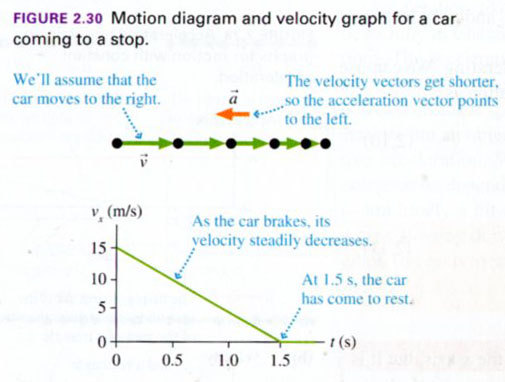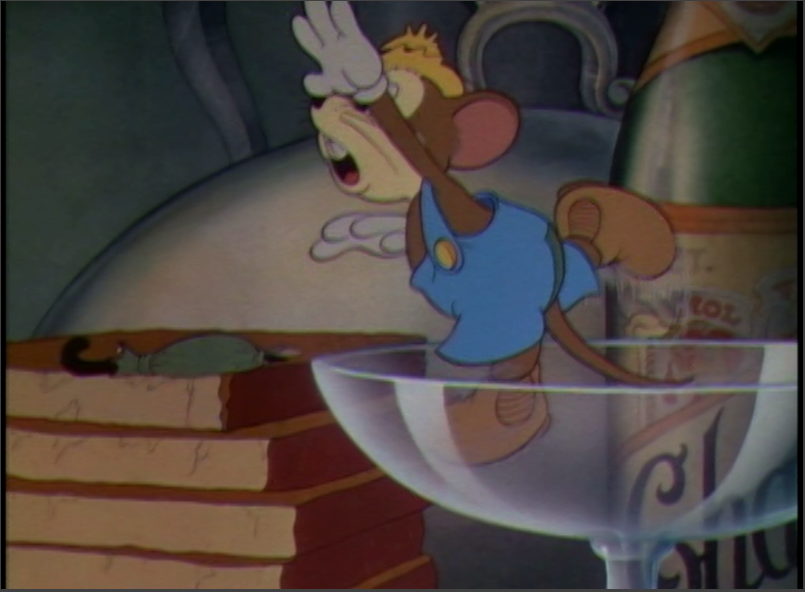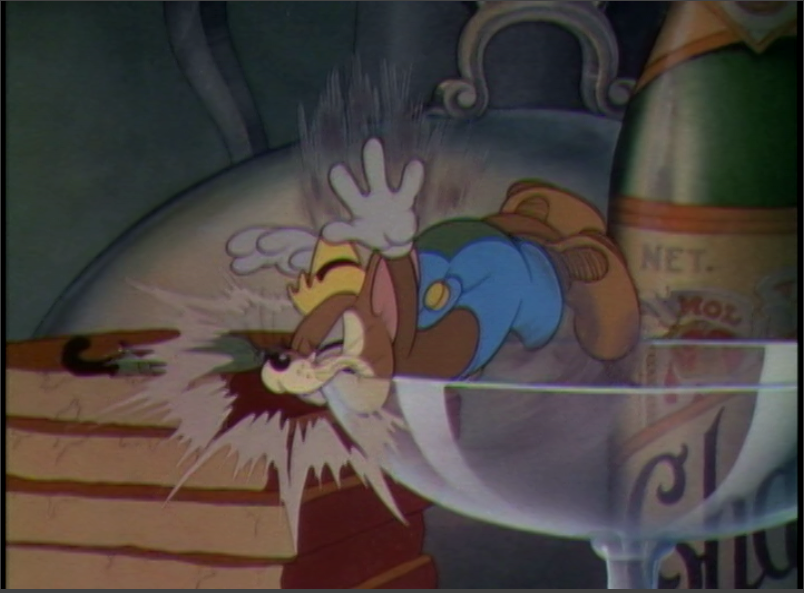Art Babbitt is often quoted as saying that “animators follow the laws of physics unless it is funnier otherwise.” In the spirit of this idea, I collaborated with Krishna Chowdary, a physics colleague at Evergreen, to design a project in which undergraduates in our program “Trajectories in Animation, Mathematics and Physics” subjected clips of animation to kinematics analysis. The goals of this were for students to strengthen the observational and analytical skills they’d practiced on several real world phenomena using LoggerPro and apply them to phenomena in animated worlds in order to begin to develop theories about how and why different animators use or alter the rules of physics in their works. In this presentation for the SAS annual conference at USC, in 2013, I described the project and reported on students’ findings and how they applied them to their own animated works. I assessed this approach as a method for integrating the teaching of physics into the teaching of animation, and vice versa, and for beginning to quantify, visualize and identify stylistic differences in the ways different animators choose to represent motion.
You can see the actual assignment here.
Various sources quote Art Babbitt, as saying that “Animation follows the laws of physics unless it is funnier otherwise.”[1] To explore the limits of this statement as well as make use of it as a focus for our teaching, my co-teacher Krishna Chowdary, physics faculty at The Evergreen State College, and I collaborated on the design of an assignment in which undergraduates in our two quarter (20 weeks) program[2] “Trajectories in Animation, Mathematics and Physics” would analyze clips of animation using LoggerPro, an application for quantifying real world motion. Our goals were for students to strengthen the observational and analytical skills they’d practiced on real world phenomena, apply them to motions in animated worlds and to derive theories from this data about how and why different animators use or alter the rules of physics in their works. In this paper I’ll describe the specifics of the assignment, report on students’ findings and how they applied them to their own animated works. I will conclude by assessing this approach as a method for integrating the teaching of physics into the teaching of animation, and vice versa, for furthering animation studies by quantifying, visualizing and identifying stylistic differences among different animators’ representations of motion and for its potential for creative play by animators.
A strategy of planning interdisciplinary programs is to organize syllabi around guiding questions. When we were planning Trajectories, Krishna brought up Babbitt’s quote to help formulate the questions around the different ways in which physics, motion, our perceptions of movement and time and change are “funny”, not only in terms of what makes us laugh but also what is odd or interesting or uncanny about these phenomena.
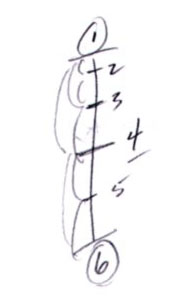
An animation timing chart
Students began work in fall with a brief study of physical comedy in cinema, looking at Buster Keaton films and reading excerpts from Noel Carroll’s Comedy Incarnate and Henri Bergson’s essay On Laughter. I taught basic principles of animation, using zoetrope strip exercises for simple motions; bouncing ball (projectile), walks (rotational), staggers and waves (oscilliatory). Students[3] animated short sequences representing physics concepts using drawn and cut-out techniques, practicing how to represent real world physics relatively accurately and how to exaggerate or manipulate motions so as to increase anticipation, for comedic effect, or other expressive purposes. In screenings of works by a variety of traditional and experimental animators, we asked students to observe what they could conclude about the physics of an animated world based on the motions and timing they’d observed in a particular film.
At the same time Krishna taught students classical mechanics, including how to use motion diagrams to abstract out and quantify a motion[4], and how to observe and analyze real world physics using motion detectors to gather data in the lab and on a field trip to an amusement park. They subjected video clips to motion analysis using Logger Pro, attempting to derive mathematical formulae that described specific motions.
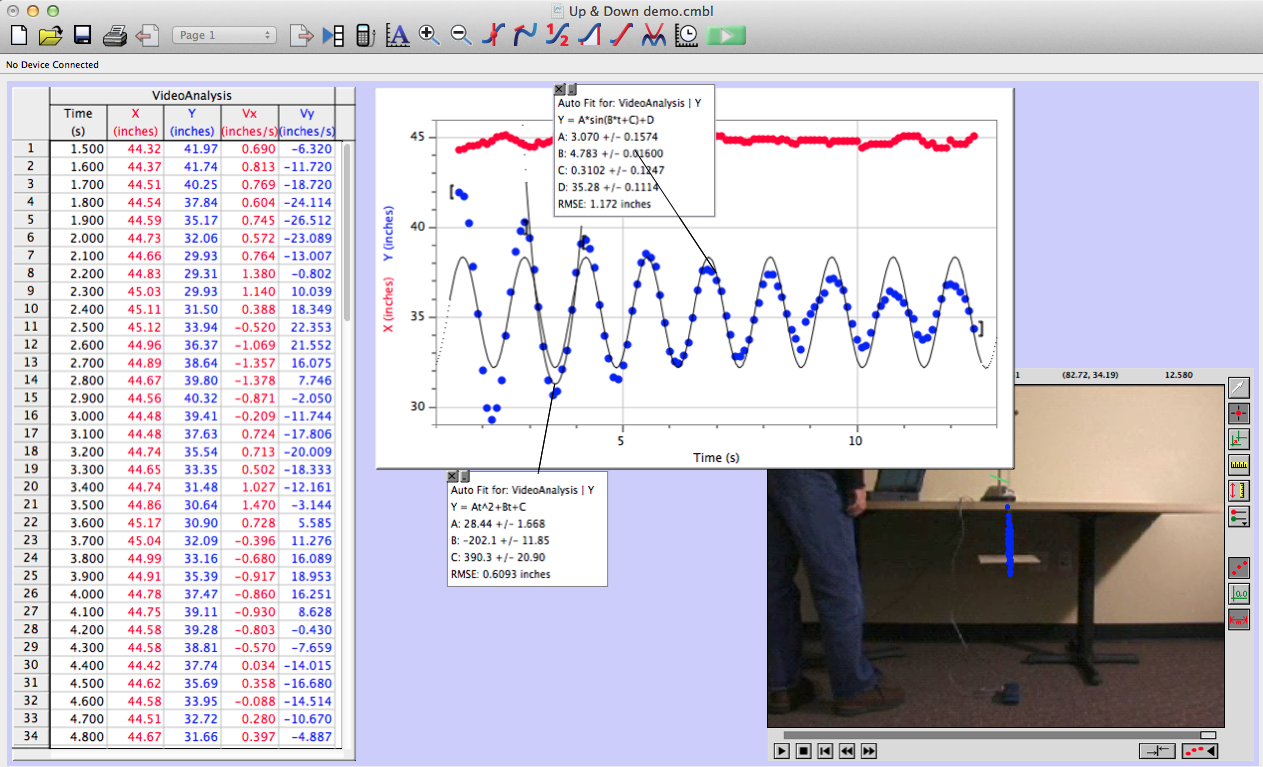
Screen grab from a Logger Pro analysis of a live-action motion with data columns and graphs of position/time, velocity/time and acceleration/time with curve fit.
While watching students apply Logger Pro analysis to live-action video clips it occurred to me that we could easily use this tool to analyze animated motion. So we designed the Animation Analysis Assignment, the final one for the quarter. In two parts, it asked students to analyze clips of animated motion to quantify them and then to base original animation on those kinematics.
I hoped that this would kill a few birds with one stone:
- It would support our teaching of physics by having students practice applying physics analysis tools.
- As they viewed and worked with different animated sequences frame by frame, students might sensitize themselves to the nuances of animation timing and would learn tricks of timing that they could then use in their own works.
- There’s a precedent in Visual Arts training to copy old master drawings and paintings. Having students attempt to replicate the kinematics of an animated motion would increase their understanding of timing.
- It would shift students out of a passive viewing mode that simply follows narrative to one that also pays attention to how design and styles of motion affect viewers’ reception of the works.
- Students would develop a more objective descriptive language informed by physics as they studied and wrote about animated motion quantitatively.
- I wanted them to investigate more specifically what deviations from real world physics might contribute to the humor of a work, and what other reasons besides humor animators might have for imposing different physical laws than we experience in the real world.
- I saw this as an opportunity for myself to explore questions about how to describe different animator’s styles of movement and timing, given an apparent lack of literature on that in animation studies.
The films that we’d screened during the first part of fall quarter were selected based on our readings of excerpts of Furniss’ Animation Bible, Wells’ Animation: Genre and Authorship, Place-Verghnes’ chapter The Provisional Nature of the Averyan Universe[5], and Sifianos’ discussion of McLaren’s comments about animation timing.[6] I compiled clips from these films and divided them roughly into two categories, “traditional” or “orthodox”, and developmental or experimental, to use Well’s terms. Students were assigned to compare films with different goals and different production conditions (for example, established studio as opposed to independent).
Group A (“orthodox”)
- Country Cousin, Disney Studios, 1936
- The Old Mill, Disney Studios, 1937
- Scherzo (Weather Beaten Melody), Hans Fischerkoesen, 1942
- Bad Luck Blackie, Tex Avery, 1949
- Manipulation, Daniel Greaves, 1991
Group B (“experimental”)
- Pencil Booklings, Kathy Rose, 1978
- Some Protection, Marjut Rimminen, 1987
- Gerald McBoing Boing, UPA, 1951
- Steamboat Willie, Disney Studios, 1928
- Mr Tete, Jan Lenica, 1959
- Studie #7, Oskar Fischinger, 1931
In the first part of the assignment, students had to analyze two motions from two clips each, one clip from each category (analyzing a total of 4 motions). First they had to view the clips and reverse storyboard them, drawing thumbnails of what they thought were significant changes in action in each. This step was meant to help them identify which motions within each clip they wanted to focus on.
Once they’d identified specific motions, they had to rotoscope them, either by tracing in the traditional way, or by freehand drawing. This step called for them to familiarize themselves with each motion by stepping through it frame by frame. Several students reported “aha” moments through this process as they discovered subtle mid-air pauses, blurs and other devices that animators had integrated into the works.
Then students imported the clips they’d chosen into Logger Pro to motion track them and generate quantitative data and graphs representing position/time, velocity/time and acceleration/time. This step required that they impose a world scale, deciding what units of measurement they would depend on (centimeters vs inches) and how they would determine distances. For example, students calculated the length of a mouse nose or “of a scarlet macaw from the tip of a beak to the end of a tail”[7].
After generating graphs, they used LoggerPro’s curve fitting functionality to find mathematical relations that describe the motions chosen. Then they had to write a report of their findings.
In the second part of the assignment, students were asked to animate a response using the kinematics of one motion. This required them to think abstractly and strip away the image content and the actual motion to adapt the dynamics and timing to their own work.
Students’ written reports and discussions of their findings show increased physics observation skills and ability to identify how animators manipulate representations of physics and their motivations for altering realistic physics in their work. As they studied these different clips, it became clear to them that while Babbitt may have followed the laws of physics unless it was funnier otherwise, other animators have used or misused the laws of physics for a range of reasons in addition to attempting to be funny.
You can see how Babbitt implemented this concept in this clip from Country Cousin (Disney, 1934) where throughout the scene showing the inebriated country mouse, physics are exaggerated for humorous effect.
Consistent with his statement, Babbitt’s work on the drunken sequence in Country Cousin shows significant deviation in how physics is represented from the somewhat normalized motions of the first sequences to the more exaggerated, broader motions of the drunken sequences. This extended sequence is the climax of the cartoon with the most comedy, reflective of traditions of physical humor, but it also, as one student noted, effectively portrays the distortions and disorientations of the experience of being drunk[8].
1) Into glass: (Zach) “When the mouse has just slipped and begins to fall, the rate at which he accelerates and falls on his face seems to exceed normal free-fall acceleration. In a single frame the mouse goes from standing to flat on his face; once again exaggeration is used in the animation to represent some physical concept.”
2) Hat: (Jake) “The hat falls at a length of .8 seconds and fell a little over 100 cm… which would be a little more than a meter a second, much slower than the 9.8 meters per second of the practical world and certainly slower than the initial jump. …CC exaggerates the descent of the hat.” (Sam) “…when the hat reaches its apex, its stays there for a few frames. This makes for a funny exaggeration of what would be a correct physical representation of a hat flipping through air.”
3) Into bread: (Zach) “In this case, when two objects collide… (the umbrella and the bread it comes in contact with), the force not controlled by the main character seems to be greater than the one exerted by the mouse.” (Zach) “there seems to be a theme here that the physical environment of the mouse’s world is more concrete and therefore harder to affect, at least for the protagonist.”
4) City cousin reaction: Corey’s measurements of him “jumping out of his skin” in alarm. Exaggeration helps communicate the magnitude of the reaction, not only for humor, although the exaggeration is humorous. It increases tension, helping the audience feel his alarm and become alarmed themselves.
5) Jake’s comments on Country Cousin descent of hat: “Suddenly the world that had such urgency and speed becomes sedated in its newly liquored state.”
Two students (Sasha and Josh) noted constant velocity in projectile motions in Steamboat Willie. The bucket that Mickey tosses at the parrot moves at the same speed no matter where in the arc it is.
Show slide of the bucket toss at parrot in Steamboat Willie, with Logger Pro data points.
This lack of attention to any sort of physics, realist or otherwise, might suggest the learning process that early Disney animators were still going through. On the other hand, as one student commented, it is a short enough flight that you don’t notice the abnormality. Other students noted motions that emulate real world physics, such as Mickey’s fall down the stairs that approximates freefall velocity (Will). Other motions employ physics that are conditional and that vary in response to comedic goals or the needs of the plot.
One student (Ian) compared the physics of Steamboat Willie with The Old Mill, detecting differences in the sometimes exaggerated physics of the former and it’s comedic goals with the more subtle, hyperrealist physics (and imagery, including use of the multiplane) of the latter, that serve to elicit empathy or increase suspense.
Show slide from Old Mill of mother bird in nest
Mill blades discrepancy
Students studying a clip from Fischerkoesen’s Scherzo noted similar strategies to build empathy. One (Helen) observed that realistic motion helped anthropomorphize the bugs: “Scherzo was probably trying to delight the viewers by showing bugs acting with realistic motions in a way we often relate to humans, while mixing in some reminders of their buggy nature. They can do things we can’t – twist around like the caterpillar, fly like the bee – but they are still bound by the same laws of physics as us. Showing interesting and clever movements adds to the delight the viewers feel.” [9] Another measured the bee’s speed and compared it to estimates of European honeybee speed to discover that it was significantly slower. She didn’t attempt to draw a conclusion about Fischerkoesen’s intentions for this, but one can easily assume the leisurely pace of the bee, matched with the music, helped draw viewers in and relax them into accepting the conditions of this world. And if you’ve read Moritz’ analysis of Scherzo in his article on Fischerkoesen, you might assume the filmmaker had other subversive intentions.
One of the animators who perhaps most exemplified Babbitt’s idea of the relationship between animation and physics was Tex Avery. In their studies of Bad Luck Blackie, students confirmed Place-Verghnes’ findings as similar to motivations of Country Cousin.
1) Josh’s comparison of projectile motion compared with Steamboat Willie. “I did not notice the first twelve times I watched that …specific clip how long the whistle lingers in the air. Sure it’s only a half a second, but …it felt like a slap in the face. “
2) General: (Fiona) “The physics are highly conditional, altered for the sake of comedic timing with no real story or reason. When the dog hurls the horse shoe into the air, the laws change to reflect his bad luck.” “I think the animator wanted to make the actions seem bigger…The slowing of the horse shoe built anticipation, while the rapid acceleration gave me the impression that the horseshoe was extremely heavy.”
3) General: (Isaac) “…contains a more realistic sense of physics [than Studie #7]…They follow basics rules but make up their own ratios for how they should react, gravity exists but perhaps it is 20 m/s/s instead of 9.8. The physics also seem to be relative to the scene itself.”
4) Jack in the box: (Daniel) dampened sine wave. “The period T of our motion here is approximately .35 seconds, and the average bulldog is about 25kg, with only about 3/5 of him actually not acting as the spring….”
5) (Justis) this “seems to be a world with highly malleable physics, based largely on the necessities of the plot. Overall however I would say there is an emphasis placed on rapid acceleration. I found in analyzing the motion of the dog’s hand a he swats a fly on his face that within the passing of a single frame the velocity can be seen to rocket from -21 m/s to -106 m/s. In this motion it was difficult to determine a mathematical function to use because it is a very sudden fast movement framed on either side by much slower changes.”
In his comparison of the motions in Manipulation with Gerald McBoing Boing, one student focused on the effects communicated by oscillatory motions in each, noting that in the former the motion adds energy, while in the latter it drains energy[10]. Manipulation is Greaves’ fairly self-conscious exercise in cartoon physics with similar exaggerations as Country Cousin although framed in the classic trope of the animator ‘s reflexivity in announcing his own presence and control of the character. The oscillatory motion of the ball in Manipulation doesn’t lose kinetic energy. It keeps on going longer than one would expect in a real world situation. It creates a feeling of “playful excitement” as another student remarked.[11]
The motion in Gerald McBoing Boing in contrast deviates from classical cartoon physics. It is minimalist, with specific motions frequently isolated by static holds. In Gerald the decaying oscillatory motion of the father bouncing on the springs of his chair expresses his despair at his son’s noisemaking habits. The decaying oscillatory bounce is closer to real world physics because it does decay, although clearly the bounce itself is more exaggerated than what would happen if one landed on a chair from the height of the ceiling. In any case, the motion is used with other effects (the fade to black, the audio) to communicate the father’s emotional state.
Another student compared Country Cousin with Jan Lenica’s Mr. Tete and commented on how the technique of cut-out animation tends towards choppy, disjointed movements. The cut-out pieces are inherently more static than an animated sequence of drawings. The motion style is minimalist in a similar way to Gerald with its embrace of the inherent static qualities of the cel animation technique. This student discussed how Lenica’s motion style, contrasting choppy motion with relatively smoother ones contributes to his portrayal of an alienating social system[12].
a. Trevor; the nature of the cut-outs leads to concreteness. Physics never constant, always in flux. But objects landing instantly come to rest. The nature of the art medium determines somewhat the physics that are used.
b. Some Protection: Helen’s observations that motions are free and sweeping when she is feeling positive, in the “real world” while other moments like when she recognizes her lack of money, her motion is realistic and constrained. “Realism is used to represent negative emotions or a disconnect from reality.” “The dreamy atmosphere of the real world – the worlds outside the institution – is shown as a circus, something strange and foreign. The correlating surreal motion helps [elicit] a feeling of drifting through life, lost in a strange, bright, demanding world.”
2) Conclusion and assessment:
a. This assignment posed several challenges for students.
i. It was complicated, involving many steps that required attention to technical detail without a lot of overt faculty guidance so students had to work independently
ii. It asked them to exercise judgment and problem solving skills. For example isolating a measurable motion that seemed representative of that particular animation, the need to establish units of measurement (“a mouse nose”, “the length of a scarlet macaw from the tip of a beak to the end of a tail”) as well as weight (the average weight of a bulldog or a horseshoe).
iii. need to identify motions that lent themselves to measurement in Logger Pro,
iv. in writing up findings they needed to develop language to describe their observations, translating them from the quantitative to qualitative.
b. students’ reflections on their work and what they learned.
c. Increased understanding of the constructed nature of animation, as evidenced by the ability to separate the fact of a motion and its role in a narrative or sequence, and the abstract qualities of its kinematics and timing.
i. Many focused on creating new animation whose only link to the motion analyzed was that it had a version of that motion in the action. Several incorporated varieties of freefall that they’d analyzed but didn’t do much with it conceptually. For these students, the idea of adapting the kinematics, rather than the motion itself was a bit of a stretch.
ii. Some focused on the specific few frames that characterized an animator’s motion for them. Josh, a juggler, was intrigued by the several frame pause at the arc of a whistle’s trajectory in Bad Luck Blackie so he focused on that: “My idea was to take this seemingly unnoticed pause, and bring attention to it through the medium of animated cut-out juggling. I had one of three balls stop moving in the vertical direction and spin for five frames. While that was taking place, the other balls were thrown back and forth between the hands. I can’t say I had much of a goal, per se, I just thought it would be visually interesting, and contrast the fluidity that composes juggling.”
iii. The analysis of animator’s motions led several of the science students to abstraction, the representation of mathematical concepts or an exploration of musical structure:
1. Joel: adapting simple harmonic oscillation from Manipulation to create an abstract sequence, Period, with the goal of showing how harmonic motion and circular motion relate. “This piece is an exploration of the sublime mathematics of the circle, and how trigonometric ratio functions and pi bridge the gap between harmonic oscillation, circles and triangles. This is the ‘old brain’ of math: beauty and symmetry that is immediately visible.”
2. Isaac, after consultation with faculty, converted the time vs motion graph he’d made from analyzing Fischinger’s Studie #7 into a short piece of cut-out animation. The directions of the motion are different, however the feelings the motions evoke are very similar.
3. Daniel created Canon in C(at) using Avery’s prancing black cat repeating in cycles to create a take on visual music. Skill levels not up to par, but strong concept. “This clip attracted me especially because of the simplicity of it, the straightforward smug propulsion of a cat who means business, and then [to] have him be manipulated in ways he couldn’t expect, being slowed down, sped up, changed color and made to prance with copies of himself, a kind of pawn to my modes of madness.” Using repetition to emphasize a quality of a particular motion.
iv. Interest in abstraction not as present in arts students, although Jake, the one who did move in this direction, took a more intuitive and conceptual approach, stripping down of a dancer image (inspired by Engel’s Accident) to explore persistence of vision. Contrast hyperrealism of Disney with minimalist aesthetic of Lenica’s Mr Tete.
d. Art students- animation learning as evidenced by their sequences, artist statements and reflections.
i. Increased understanding of timing led to improvisation in the form of straight ahead animation and/or invention of characters and reinvention of gags.
1. Justis contrasting realist rotoscoped motion with cartoon motion and the trope of animator in conflict with his character. Chose Avery’s style of animation to interact with his rotoscoped self. Inspired by the way Chris Sullivan works, he animated straight ahead to match with rotoscoping. “…it was nerve-wracking to start. I would draw the frames, shoot them, and then go back and redraw them completely for the first second or so after the character appeared. But at a certain point I found myself understanding on a much deeper level how to pace and time the movements.”
2. Fiona adapted the movement of Mickey’s arms from Steamboat Willie and applied it to her own character, literalizing it as a squid. But notes that her entire process was improvisatory, not so much in the step by step process of animating, but in putting the sequence together.
3. Ruby: adapting the sequence of objects falling on the bulldog from BLB to a different character with live animals falling on her. Sets up problem of what the animals do when they hit the ground.
ii. Will: portraying states of sobriety and drunkenness using two different physics, borrowed from Steamboat Willie (the fall down the stairs) and Country Cousin (the way smoke rises). Noticing it as a recurring theme in animation.
iii. Helen borrowed a leap from Some Protection and built motions around it, designing a simple female character in a leotard. She also borrowed Rimminen’s strategy of having the character fade away and reappear in other places to develop a sequence composed of the character’s acrobatic motions across a blank space. She writes: “Through this project I learned more about human motion and using transitions …”
e. Nearly all students gained a greater understanding of the role of preproduction design by being challenged to adapt another animator’s work. They had to establish some kind of logic to the universes they created that would justify their use of the motion or its kinematics. Many reflected on their preproduction process afterwards, seeing it as the main part of the problem solving that they did.
3) Conclusions:
a. This was a useful assignment for enforcing students learning of basic physics concepts-enjoyment from scrutinizing animated sequences frame by frame, “aha” factor from discovering how much of particular actions was really left to the viewer (as in the Avery cartoon).
b. Useful for students developing their own sense of animation timing as well as the importance of preproduction.
c. We needed more time for the last step, coaching students through adapting kinematics to their own sequences without replicating the actions. While many of their responses were quite wonderful, not all of them successfully adapted the kinematics as accurately as I’d envisioned. But it was a good jumping off point for creative work. Sort of a carrot on the stick of analysis for the art students.
d. Coordinated studies model with interdisciplinary ethos-important structure to support this work, but could be adapted to other institutions, especially if there is enthusiastic physics faculty available.
e. Suggests a direction for a more systematic and analytical study of animators’ motion styles and timing using this software. Could there be a scale of these styles based on quantitative data?
f. I have not had time to do a systematic literature review to find out what has been written about animators styles of movement and timing (as opposed to imagery, characterization). This would be a good next step.
g. Suggested direction for creative work: deriving formal explorations of animated movement by appropriating kinematics of particular motions and playing with them. Converting slopes of the three graph types to paths of action is an obvious one.
4) Attach copy of the assignment as an appendix.
[1] See O’Donnell’s Laws of Cartoon Motion, Esquire, 6/80
[2] Evergreen is an experimental, interdisciplinary liberal arts college. The curriculum is largely composed of full-time, team taught, interdisciplinary “programs” that frequently last multiple quarters, enabling faculty and students to develop a learning community through which they can approach common questions from multiple disciplinary perspectives. Programs generally begin by emphasizing breadth, but by the second or third quarter lead students into depth in one or more areas. For faculty, one of the benefits of teaching with someone in a completely different discipline is that we learn a lot of new things, and discover ways in which our own disciplines can be expanded by connections with new concepts and practices.
[3] We had 42 students, from first years to seniors. About half were pursuing studies in the sciences with the other half focusing in the arts.
[4] Motion diagrams for physics are very similar to animation timing charts.
[5] Tex Avery: A Unique Legacy
[6] “The Definition of Animation: A Letter from Noran McLaren”, Animation Journal, Vol 3 # 2.
[7]
[8]
[9] HP
[10] JT analysis
[11] KB analysis
[12] JH analysis

